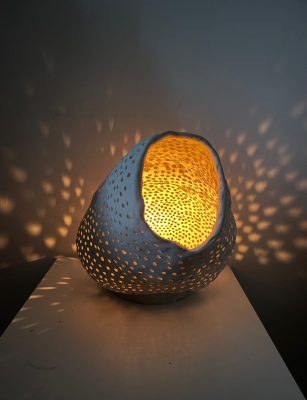

Sardegna, terra mia.
Iknùsa (orma di piede umano), Sandàlion o Sandaliòtis (sandalo), Kadossène (pantofola degli Dei), Srdn (Sardan) per i fenici o Sardon per gli ellenici, Sardinia per i latini, Sardigna nel medioevo, infine Sardegna.
Adagiata quasi al centro del Mediterraneo, isola arcaica, quasi primitiva, per un tempo lunghissimo legata ai cicli della natura, alle tradizioni e a una religiosita’ diffusa.
I venti (ponente, levante, maestrale) soffiano quasi continuamente, la dominano, la feriscono, la forgiano fornendo sculture naturali, rocce parlanti, alberi che crescono nello spazio in senso orizzontale.
Terra aspra, selvaggia, dove lo spazio e la solitudine si espandono a dismisura come nella zona del Gennargentu e del Supramonte, dove si possono percorrere chilometri senza incontrare nessuno;
terra di uomini dalla voce dura, terra di rocce e di uccelli rapaci, terra arida e povera d’acqua;
ma anche terra di profumi, di ginepro, elicriso, lavanda selvatica.
La Sardegna contiene la zolla piu’ antica d’Italia e leggende avvolgono le origini del popolamento (gli Shardana, re Sardus, i Balari);
varie fasi si succedettero, si sviluppò la civilta’ dei prenuragici interessati ai giacimenti di ossidiana e rame e poi ad altre attivita’, soprattutto alla pastorizia e all’agricoltura, seguiranno i nuragici, popolo di cui ignoriamo il nome ma che per convenzione, identifichiamo con il monumento tipico, il nuraghe e nel contempo troviamo luoghi di culto come i tempietti, i pozzi sacri, le tombe dei giganti.
Una civilta’ mediterranea definita da molti particolare e complessa, che ha saputo mantenere una propria identita’ autoctona, connessa soprattutto con la natura, tendente ad indirizzare e dominare le energie negative attraverso i simboli magici, luogo di magia e antiche conoscenze.
Cio’ che la rende unica sono le antiche vestigia di un passato megalitico esoterico, le migliaia di costruzioni in pietra che sfidano il passare del tempo e ci appaiono spesso misteriose, eredita’ di avi molto lontani.
Oggi la Sardegna e’ cambiata, sta ancora cambiando ma e’ ancora possibile, per chi vuole vedere e capire, compiere un viaggio nel tempo che scorre sempre piu’ velocemente, cercando condotti con energie ancestrali appartenenti ad un mondo mistico esaltato attraverso l’architettura, con una natura severa, con un ambiente ancora incontaminato, ricco di animali selvatici e di scorci inaspettati che lasciano stupefatto lo spettatore.
Sardinia, my land.
Iknùsa (human footprint), Sandàlion or Sandaliòtis (sandal), Kadossène (slipper of the Gods), Srdn (Sardan) for the Phoenicians or Sardon for the Hellenes, Sardinia for the Latins, Sardinia in the Middle Ages, finally Sardinia.
Lying almost in the center of the Mediterranean, an archaic, almost primitive island, for a very long time linked to the cycles of nature, traditions and widespread religiosity.
The winds (west, east, mistral) blow almost continuously, dominate it, wound it, forge it, providing natural sculptures, speaking rocks, trees that grow horizontally in space.
Harsh, wild land, where space and solitude expand out of all proportion as in the Gennargentu and Supramonte areas, where you can travel for kilometers without meeting anyone;
land of men with harsh voices, land of rocks and birds of prey, arid land poor in water;
but also a land of perfumes, of juniper, helichrysum, wild lavender.
Sardinia contains the oldest soil in Italy and legends surround the origins of the population (the Shardana, King Sardus, the Balari);
various phases followed one another, the civilization of the pre-Nuragic people developed, interested in the obsidian and copper deposits and then other activities, especially sheep-rearing and agriculture, followed by the Nuragic people, a people whose name we ignore but who by convention, we identify with the typical monument, the nuraghe and at the same time we find places of worship such as temples, sacred wells, giants’ tombs.
A Mediterranean civilization defined by many as particular and complex, which has managed to maintain its own indigenous identity, connected above all with nature, tending to direct and dominate negative energies through magical symbols, a place of magic and ancient knowledge.
What makes it unique are the ancient vestiges of an esoteric megalithic past, the thousands of stone constructions that defy the passage of time and often appear mysterious to us, legacies of very distant ancestors.
Today Sardinia has changed, it is still changing but it is still possible, for those who want to see and understand, to take a journey through time that flows more and more quickly, looking for conduits with ancestral energies belonging to a mystical world exalted through architecture , with a severe nature, with a still uncontaminated environment, full of wild animals and unexpected views that leave the spectator amazed.

